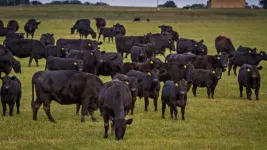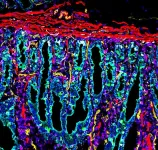(Press-News.org) Nearly a century ago, physicists Max Born and J. Robert Oppenheimer developed an assumption regarding how quantum mechanics plays out in molecules, which are comprised of intricate systems of nuclei and electrons. The Born-Oppenheimer approximation assumes that the motion of nuclei and electrons in a molecule are independent of each other and can be treated separately.
This model works the vast majority of the time, but scientists are testing its limits. Recently, a team of scientists demonstrated the breakdown of this assumption on very fast time scales, revealing a close relationship between the dynamics of nuclei and electrons. The discovery could influence the design of molecules useful for solar energy conversion, energy production, quantum information science and more.
“Understanding the interplay between the spin-vibronic effect and inter-system crossing could potentially lead to new ways to control and exploit the electronic and spin properties of molecules.” — Lin Chen, Argonne Distinguished Fellow and professor of chemistry at Northwestern University
The team, including scientists from the U.S. Department of Energy’s (DOE) Argonne National Laboratory, Northwestern University, North Carolina State University and University of Washington, recently published their discovery in two related papers in Nature and Angewandte Chemie International Edition.
“Our work reveals the interplay between the dynamics of electron spin and the vibrational dynamics of the nuclei in molecules on superfast time scales,” said Shahnawaz Rafiq, a research associate at Northwestern University and first author on the Nature paper. “These properties can’t be treated independently — they mix together and affect electronic dynamics in complex ways.”
A phenomenon called the spin-vibronic effect occurs when changes in the motion of the nuclei within a molecule affect the motion of its electrons. When nuclei vibrate within a molecule — either due to their intrinsic energy or due to external stimuli, such as light — these vibrations can affect the motion of their electrons, which can in turn change the molecule’s spin, a quantum mechanical property related to magnetism.
In a process called inter-system crossing, an excited molecule or atom changes its electronic state by flipping its electron spin orientation. Inter-system crossing plays an important role in many chemical processes, including those in photovoltaic devices, photocatalysis and even bioluminescent animals. For this crossing to be possible, it requires specific conditions and energy differences between the electronic states involved.
Since the 1960s, scientists have theorized that the spin-vibronic effect could play a role in inter-system crossing, but direct observation of the phenomenon has proven challenging, as it involves the measurement of changes in electronic, vibrational and spin states on very fast time scales.
“We used ultrashort laser pulses — down to seven femtoseconds, or seven millionths of a billionth of a second — to track the motion of nuclei and electrons in real time, which showed how the spin-vibronic effect can drive inter-system crossing,” said Lin Chen, an Argonne Distinguished Fellow, professor of chemistry at Northwestern University and co-corresponding author on both studies. “Understanding the interplay between the spin-vibronic effect and inter-system crossing could potentially lead to new ways to control and exploit the electronic and spin properties of molecules.”
The team studied four unique molecular systems designed by Felix Castellano, a professor at North Carolina State University and co-corresponding author on both studies. Each of the systems is like the other, but they contain controlled, known differences in their structures. This allowed the team to access slightly different inter-system crossing effects and vibrational dynamics to get a fuller picture of the relationship.
“The geometrical changes that we designed into these systems caused the crossing points between the interacting electronic excited states to occur at slightly different energies and under different conditions,” said Castellano. “This provides insight for tuning and designing materials to enhance this crossing.”
Induced by vibrational motion, the spin-vibronic effect in the molecules altered the energy landscape within the molecules, increasing the probability and rate of inter-system crossing. The team also discovered key intermediate electronic states that were integral to the operation of the spin-vibronic effect.
The results were predicted and bolstered by quantum dynamics calculations by Xiaosong Li, a professor of chemistry at the University of Washington and laboratory fellow at DOE’s Pacific Northwest National Laboratory. “These experiments showed very clear, very beautiful chemistry in real time that aligns with our predictions,” said Li, who was an author on the study published in Angewandte Chemie International Edition.
The profound insights unraveled by the experiments represent a step forward in the design of molecules that can make use of this powerful quantum mechanical relationship. This could prove especially useful for solar cells, better electronic displays and even medical treatments that rely on light-matter interactions.
Both studies were supported by DOE’s Office of Science. The Nature study was supported in part by the National Science Foundation. Experiments in the Angewandte Chemie International Edition were conducted at the Linac Coherent Light Source at DOE’s SLAC National Accelerator Laboratory. Other authors on the Nature study include Nicholas P. Weingartz and Sarah Kromer. Other authors on the paper published in Angewandte Chemie International Edition include Denis Leshchev, Andrew J. S. Valentine, Pyosang Kim, Alexis W. Mills, Subhangi Roy, Arnab Chakraborty, Elisa Biasin, Kristoffer Haldrup, Darren J. Hsu, Matthew S. Kirschner, Dolev Rimmerman, Matthieu Chollet, J. Michael Glownia and Tim B. van Driel.
END
Unveiling the quantum dance: Experiments reveal nexus of vibrational and electronic dynamics
Coupling of electronic and nuclear dynamics revealed in molecules with ultrafast lasers and X-rays
2023-07-19
ELSE PRESS RELEASES FROM THIS DATE:
Gender disparities in Lyme disease: Women face higher risk of severe and prolonged illness
2023-07-19
Women with Lyme disease take longer to get diagnosed, have more severe symptoms and experience higher rates of disability when compared to men. They may also be more likely to develop persistent Lyme disease. Those are among the findings of a recent study that analyzed information from the MyLymeData patient registry. The results have been published in the International Journal of General Medicine.
The present study, which was conducted by LymeDisease.org, a research and advocacy organization, assessed sex-based differences in Lyme disease patients who remained ill for six months or more after antibiotic treatment. In ...
New study uses gene prediction tool to select premium grade Angus herds in Missouri and across the United States
2023-07-19
Ranches across the Show-Me State manage approximately two million cattle — a significant number of which are Angus, a top-tier breed that has unrivaled success in the commercial beef market. In a new study, University of Missouri researcher Jared Decker and Thompson Research Farm tested a group of commercial Angus cows using a commercial genomic prediction tool called Zoetis GeneMax Advantage to investigate the ability of the test to predict their calves’ performance and profitability. This project demonstrates ...
Tracing maternal behavior to brain immune function
2023-07-19
COLUMBUS, Ohio – Immune system changes in the pregnant body that protect the fetus appear to extend to the brain, where a decrease in immune cells late in gestation may factor into the onset of maternal behavior, new research in rats suggests.
In adult female rats that had never given birth – which typically don’t like being around babies – depletion of these cells sped up their care for rat newborns that were placed in their cage.
The loss of these cells, called microglia, and the related uptick in motherly attentiveness were also associated with changes to neuron activity in several regions of the rat brain, suggesting ...
Stanford Medicine researchers map morphing placenta
2023-07-19
Early in pregnancy, something strange happens in the uterus: Cells from the fetal side of the developing placenta invade the uterine endometrium and work with the mother’s immune system to remodel the arteries.
“When I first read about it, I thought, ‘This is so bizarre,’” said Stanford Medicine pathologist Michael Angelo, MD, PhD.
Humans’ immune systems usually attack unfamiliar cells, which would theoretically pose a problem for a developing pregnancy. But on the mother’s side of the growing placenta, the arteries incorporate cells that genetically match the embryo, just one of ...
It’s a beautiful day in the intestinal neighborhood
2023-07-19
When you think about your ideal neighborhood, perhaps you think of tree-lined streets or a close-knit community of people who help each other. You probably don’t think about your digestive system.
But maybe you should. According to a team of scientists led by researchers at Stanford Medicine, there are indeed “neighborhoods” of different cell types cooperating to digest your food and protect you from infection, among other things — and a new, ultra-high-resolution map of these neighborhoods proves your intestine is both functionally impressive and visually striking.
Just like human neighborhoods, ...
UTHealth Houston study on seasonality of teen suicidality in JAMA Network Open
2023-07-19
The incidences of teen suicidality including self-harm, suicidal ideation, and suicide attempts increased nationally between 2016 and 2021; were at seasonal high peaks in April and October; and were at their lowest when schools were shut down during the COVID-19 pandemic, according to research at UTHealth Houston.
The study was published this month in JAMA Network Open. It was authored by Youngran Kim, PhD, assistant professor in the Department of Management, Policy, and Community Health at UTHealth Houston School of Public Health; Scott D. Lane, PhD, professor and vice chair for research in the Louis A. Faillace, MD, Department of Psychiatry and Behavioral ...
NASA funds 3 citizen science projects to study 2024 U.S. solar eclipse
2023-07-19
NASA has awarded funding for three science teams to conduct citizen science investigations as a total solar eclipse sweeps across North America on April 8, 2024. In these experiments, volunteers will help study the Sun and its ethereal outer atmosphere, called the corona, which is revealed when the Moon completely covers the Sun’s bright disk.
“During next year’s total eclipse, hundreds of volunteers will capture images of the Sun and its corona to help answer real science question about our star and how it affects us,” said program scientist and eclipse lead at NASA Headquarters, ...
Association between markers of structural racism and mass shooting events in major US cities
2023-07-19
About The Study: This study found that major U.S. cities with higher populations of Black individuals are more likely to be affected by mass shooting events, suggesting that structural racism may have a role in their incidence. Public health initiatives aiming to prevent mass shooting events should target factors associated with structural racism to address gun violence.
Authors: Michael Ghio, M.D., of Tulane University in New Orleans, is the corresponding author.
To access the embargoed study: Visit our For The Media website at this link https://media.jamanetwork.com/
(doi:10.1001/jamasurg.2023.2846)
Editor’s ...
Trends, seasonality of emergency department visits, hospitalizations for suicidality among children and adolescents
2023-07-19
About The Study: The findings of this study of 73,000 emergency department visits and hospitalizations for suicidality indicated the presence of seasonal patterns and an observed unexpected decrease in suicidality among children and adolescents after COVID-19–related school closures in March 2020, which suggest a potential association between suicidality and the school calendar.
Authors: Scott D. Lane, Ph.D., of the University of Texas Health Science Center at Houston, is the corresponding author.
To access the embargoed study: Visit ...
Two-faced star exposed
2023-07-19
In a first for white dwarfs, the burnt-out cores of dead stars, astronomers have discovered that at least one member of this cosmic family is two faced. One side of the white dwarf is composed of hydrogen, while the other is made up of helium.
“The surface of the white dwarf completely changes from one side to the other,” says Ilaria Caiazzo, a postdoctoral scholar at Caltech who leads a new study on the findings in the journal Nature. “When I show the observations to people, they are blown away.”
White dwarfs are the scalding remains of stars that were once like our sun. As the ...
LAST 30 PRESS RELEASES:
Scientists use ultrasound to soften and treat cancer tumors without damaging healthy tissue
Community swimming program for Black youth boosts skills, sense of belonging, study finds
Specific depressive symptoms in midlife linked to increased dementia risk
An ‘illuminating’ design sheds light on cholesterol
Who is more likely to get long COVID?
Study showcases resilience and rapid growth of “living rocks”
Naval Research Lab diver earns Office of Naval Research 2025 Sailor of the Year
New Mayo-led study establishes practical definition for rapidly progressive dementia
Fossil fuel industry’s “climate false solutions” reinforce its power and aggravate environmental injustice
Researchers reveal bias in a widely used measure of algorithm performance
Alcohol causes cancer. A study from IOCB Prague confirms damage to DNA and shows how cells defend against it
Hidden viruses in wastewater treatment may shape public health risks, study finds
Unlock the power of nature: how biomass can transform climate mitigation
Biochar reshapes hidden soil microbes that capture carbon dioxide in farmland
Reducing saturated fat intake shows mortality benefit, but only in high-risk individuals
Manta rays create mobile ecosystems, study finds
Study: Mixed results in using lipoic acid to treat progressive multiple sclerosis
Norbert Holtkamp appointed director of Fermi National Accelerator Laboratory
New agentic AI platform accelerates advanced optics design
Biologists discover neurons use physical signals — not electricity — to stabilize communication
Researchers discover that a hormone can access the brain by hitchhiking
University of Oklahoma researcher awarded funding to pursue AI-powered material design
Exploring how the visual system recovers following injury
Support for parents with infants at pediatric check-ups leads to better reading and math skills in elementary school
Kids’ behavioral health is a growing share of family health costs
Day & night: Cancer disrupts the brain’s natural rhythm
COVID-19 vaccination significantly reduces risk to pregnant women and baby
The role of vaccination in maternal and perinatal outcomes associated with COVID-19 in pregnancy
Mayo Clinic smartwatch system helps parents shorten and defuse children's severe tantrums early
Behavioral health spending spikes to 40% of all children’s health expenditures, nearly doubling in a decade
[Press-News.org] Unveiling the quantum dance: Experiments reveal nexus of vibrational and electronic dynamicsCoupling of electronic and nuclear dynamics revealed in molecules with ultrafast lasers and X-rays



